He Rourou, Volume 1, Issue 1, 32-48, 2021
Devender Chendri
Abstract
In recent years the emerging possibilities in the education system are flexibility (Nuhoğlu et al., 2020) and self-paced learning (Priscila, 2020). The flexibility of studying anywhere and anytime can provide opportunities for learners to achieve their educational goals. A self-paced and customised learning environment could enhance the learning experience of the students. This research evaluates flipped-learning pedagogical approaches for Year 13 Maths students. Quantitative and qualitative data collection methods track and monitor students’ academic outcomes. The findings suggest that flipped-learning improved students’ academic achievement and progress. Additionally, students who missed the lessons could understand the concept and complete learning activities before coming to the next lesson. A flipped-learning approach has encouraged the students to make them responsible for their learning, bringing questions to the classroom to extend their conceptual understanding, and develop mathematical reasoning and thinking skills.
Introduction
A shift to flexible and self-paced learning is underway in the education system, and the pace of change is mandating smarter methods with an emphasis on teaching to learning. However, the emerging challenges such as the demand to learn anytime, anywhere at your own pace are shifting gears towards the use of technology that caters to different learning styles. Indeed, due to the COVID-19 situation during the lockdown period, this researcher has scheduled Zoom online sessions for teaching and learning. Students who are turning up for these sessions enjoy this new paradigm in their education. However, this approach partially addresses the challenges because the students have to be available online to understand the lesson.
To overcome this, the study of Yoshida (2016) reveals that the requirements of flipped learning are where the learners are expected to study at home and do collaborative learning in class, autonomously take responsibility for their learning, and personalised education. Hence, these emerging challenges motivated this researcher to come up with a solution and provide a flexible platform for the learners to continue learning at their own pace.
This research was carried out at a school where there are several initiatives to raise student achievement and progress. In recent years the school arranged professional development programmes for teachers to focus on “Visible Learning” (Hattie, 2012) and “Teaching to the North-East” (Bishop, 2019).
Hattie (2012) states that visible learning and teaching means making teaching visible to students to know what to do and how to do it, and learning visible to the teachers so that they know whether learning is occurring or not. In successful classrooms, visible learning occurs when the learning goals are explicit and challenging, learners become their own teachers, teachers become learners of their own teaching, and teachers provide feedback and set high expectations for students. Bishop (2019) found that teaching to the North-East promotes learning for everyone and envisages increasing equity in the education system by responding to diverse groups of students by embracing prior knowledge, indigenous, culture and language, students with learning difficulties, and any other unique qualities they bring to the classroom rather than being seen as barriers in their learning. Thus, the purpose of this research is to evaluate the impact of the flipped-learning pedagogical approach on “Visible Learning” and “Teaching to the North-East”.
Literature Review
Flipped Learning
The definition of flipping the classroom by Maciejewski (2015) is shifting the content instruction out of class time by posting relevant online videos for students to understand on their own and assigning in-class time for conceptual practice, one-on-one and group discussions to reinforce interactive student engagement, achievement, and meet the learning needs of the students. Similarly, Yoshida (2016) defines flipped learning as the process that learners go through, blending direct instruction with constructivist learning to become skilled at the subject contents.
Flipped Learning as a Pedagogy
Bishop and Verleger (2013) emphasise that the flipped-learning classroom approach is a technology-supported pedagogy because of the direct video-based individual instructional approach outside the classroom and interactive small-group learning activities inside the classroom.
Similarly, Francl (2014) states that flipped-learning pedagogy appears to decrease the workload because of the elimination of in-class instruction time about the topic. Instead, the teacher facilitates in-class time for individual, small-group, and whole-class discussions and learning activities and for reviewing the pieces of the automated instructional video where appropriate to support the learning. The teacher’s workload is changing from an explainer to a responsive-knowledge provider by automating the instruction through videos, enabling self-pacing instruction based on learners’ response, facilitating to view the online resources on any device at any time and anywhere, setting up an online task for students to explore themselves, encouraging the learners to watch the instructional video out of class time and complete their homework in class time – either individually or in small groups, conducting in-class discussions about the concept, and testing learners’ retention and understanding with formal assessments. Bishop and Verleger (2013) highlight that various pedagogies such as problem-based learning and cooperative-learning can be used to enhance the design of flipped learning as a pedagogy.
A Hancock et al. (2013) study reveals that attendance matters for academic achievement and progress and highlights that as absence rates of the learners increase, their educational achievement continues to decline. In contrast, Harmon (2017) highlights that flipped learning helps students to catch up either at home or once they are back at school, and the students who do not have access to the internet or devices at home could use school devices to watch the required information to carry on with the task. The videos developed for flipped learning must have a good image and sound quality and a variety of online approaches for the learners to catch up on the missed lessons and meet the learning outcomes and curriculum standards. Additionally, the flipped instruction refers to moving the teaching aspects into the homework environment, differentiated teaching to meet individual learning needs, allowing more time to work collaboratively in the classroom, and promoting high-level thinking among the students.
Lo & Hew (2017) found that by using a flipped-learning approach, the impact on student performance was significantly improved compared to the traditional teaching approach. Interestingly, a Bhagat et al. (2016) study reveals that by using a flipped-learning approach, low-achievers performed better. In contrast, the average and high-achievers’ performance remained the same when compared to the traditional teacher-centred approach. In contrast, the study of Gundlach et al. (2015) critique that using traditional teaching had an impact on student performance was significantly better than the flipped-learning approach.
Main Benefits and Key Challenges
The study of Mayer et al. (2020) states that students learn better with the teacher creating instructional videos as they will be the on-screen instructor with innovative graphics, delivering engaging content and summarising resourceful explanations. The other benefits include preparing the learners for in-class discussion, understanding the concept before coming to the class, promoting on-demand learning, flexibility to watch and re-watch the videos if they have any questions, enabling learners to self-manage and take ownership of their own learning, and extending teacher reach outside the classroom including the learners who are unable to attend the class and are in need of extra time for their learning.
The three challenges of implementing a flipped-learning approach are student-related, teacher, and operational (Lo & Hew, 2017). Firstly, the student-related challenges are: not being familiar with the routines, not able to focus on watching videos, needed more precise instructions for in-class activities, increased workload because of pre-class activities at home, and lack of out-of-class support such as could not ask questions immediately while watching the videos. Secondly, the teacher challenges are not entirely familiar with this instructional approach and increased workload for preparing videos and online learning materials. Lastly, the operational challenges are: students’ computing resources at home – may not have internet access to watch the videos; monitoring students outside the class – challenging to ensure that the student has watched the video; teachers’ computing skills to incorporate flipped learning; and availability of well-equipped IT resources to support this new learning.
To overcome some of these challenges, Taffard (2020) states that open-ended questions do not have one specific answer, instead, there will be many possible answers and questions can be solved in multiple ways and on different levels. Therefore, incorporating open-ended questioning helps learners develop reasoning skills and make mathematical decisions, and teachers listen to learners’ thinking and then prompt and probe where necessary. Additionally, the research of Neely (2019) outlines that an effective way to challenge the learners and make them learn better and think more is the usage of open-ended questions.
The depth of knowledge (DOK) matrix of Robert (2015) distinguishes between cognitively demanding DOK levels (1 to 4) that feature open-ended questions. For instance, calculate an area and perimeter: a) Level 1 recall question – “Find the perimeter of a rectangle that measures 8 units by 4 units”, b) Level 2 skill/concept question – “List the measurements of three different rectangles that each has a perimeter of 20 units”, c) Level 3 strategic thinking question – “What is the greatest area you can make with a rectangle that has a perimeter of 24 units”, d) Level 4 extended thinking question relates to create, analyse, connect, critique, design, apply, prove, and synthesise.
Moreover, the swift evolution of technology and its implementation creates gaps in recent literature regarding the application of flipped-learning instructional pedagogy, online open-ended questions, and educational outcomes. Hence, to fill this gap, the present research evaluates the impact of flipped-learning approaches on mathematics concepts for Year 13 students in a secondary school.
Research Questions
The main objective of this research is to develop a flipped-learning environment by creating instructional videos with interactive online content to enhance learner-driven education. Furthermore, creating one’s own instructional videos helps personalise and customise learning content to meet individual learning needs based on learners’ profiles in the classroom and New Zealand Mathematics Curriculum levels.
Research Question 1 (RQ1):
What is the impact of flipped learning as a pedagogy on students’ academic achievement?
Research Question 2 (RQ2):
What factors contribute to students’ progress using flipped-learning pedagogical approaches?
Methodology
Action Research and Inquiry Framework
The Action-Research methodology process takes place gradually and intends to have both appropriate research and action outcomes. Moreover, it is a cyclic, qualitative, participative, reflective, and responsive approach to the emerging needs of the learners (Bob, 2020).
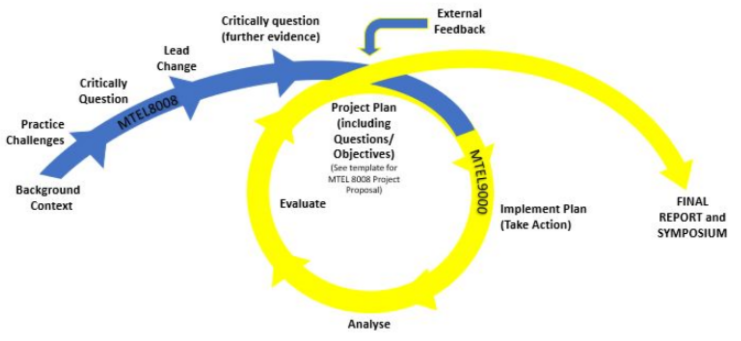
Within this, the MTEL teacher inquiry framework has been selected as an appropriate method to research because it allows the researcher to go through an iterative process of taking action, analysing, and evaluating. Therefore, there may be several iterations during the implementation of this project. To determine the success of the flipped learning, the researcher has decided on a mixed-methods approach to data collection. Wisdom and Creswell (2013) highlight that a mixed-methods approach: a) helps to understand contradictions between the results of the quantitative approach and the findings of the qualitative approach, b) gives a voice to study and reflect on participants’ point of view, c) provides methodological flexibility and is adaptable, d) collects rich and comprehensive data, and e) compares and validates findings, and creates a concrete foundation for drawing conclusions.
The main stakeholders are all students from the researcher’s Year 13 Maths class who will participate in flipped-learning activities as their regular lessons. Furthermore, the three stages of incorporating flipped-learning approaches such as Pre-Class, In-Class, and Post-Class, allow the researcher to reflect on the teaching practice for every lesson, analyse and address learning needs, and evaluate the outcome of this approach.
Flipped-Learning Pedagogy Intervention
Pre-Class: The researcher has created their own instructional videos and open-ended questions by using the Screencast-o-matics, Lucidchart, Geogebra, and NZGrapher apps as these tools were very effective for collaborating in real time, accelerating understanding with powerful diagramming and data visualisation, and allowed them to work from anywhere by using automation features to diagram faster and see mathematical ideas in a whole new light. The content in the videos was interactive and incorporated dynamic graphical representation, and this learning approach enhanced students’ visual conceptualisation. Moreover, teaching these kinds of concepts on the board would be difficult. Therefore, this researcher planned, prepared, and presented ten flipped-learning lessons. All the materials relevant to the concept were posted on Google Classroom a day before the actual flipped-learning lesson to prepare for class. All students were expected to watch this instructional video and answer the open-ended question before coming to the class. This approach shifted the content instruction out of class time, and the learners were anticipated to study at home autonomously.
In-Class: The researcher aimed to prepare the students to demonstrate the concept by setting up the instructional videos, open-ended questions, flipped-learning score-points sheet, and Google Forms to fill in the student’s voice. Additionally, the score-points sheet shared with students contained a maximum of four points and explained how they could achieve these points for each flipped-learning lesson as follows: one point for discussion about the video, one point for discussion about the open-ended question, one point for demonstrating leadership and collaboration, and one point for answering an open-ended question.
The lesson starts with a bit of discourse about the concept. Then, all students spend more time learning collaboratively in the classroom by participating in conceptual practice, small-group and whole-class discussions, and learning activities to reinforce student achievement. The researcher has more time to reach every student and meet the individual learning needs and review the pieces of an automated instructional video to support the learning. The students who could not attend the lesson could still work collaboratively online with their group members, classmates, and teachers.
During the flipped-learning collaboration, students’ names in groups were written on the board, they were to discuss their understanding of the concept from the video, and then write up their responses. The students were then asked to understand the open-ended question, discuss it in groups, and then again write up their responses on the board about their approach to the problem. Subsequently, the whole class review took place by putting what they all said together and co-constructing a plan to know what they should do next from those responses written on the board. Following this, at the end of the lesson, the students were informed about the score points they achieved for the lesson based on their participation.
Post-Class: Finally, to understand the learners’ flipped-learning experience, an exit slip was created on Google Forms and sent to all Year 13 Maths class students at the end of each flipped-learning lesson.
Data Collection Methods
According to Hattie (2012), one of the tools to understand student achievement and progress is effect-size. The effect-size measures the impact of teaching and learning approaches on student achievement and determines the efficacy of an educational intervention relative to a comparison approach. Two sets of data are required to calculate the effect-size. If the value of effect-size is positive, the intervention has an increased effect on achievement. Similarly, if the value of effect-size is negative, the intervention has a decreased effect on achievement. Using effect-sizes benefits teachers to estimate student progress and re-evaluate instructional pedagogy to customise learning for individuals and groups of students.
Subsequently, the innovation of the VLPAT (Visible Learning Progress and Achievement Tool) graph by Hattie (2012) measures individual student progress and achievement. It outlines that the x-axis represents “student-progress” or effect-size, and the y-axis represents “student-achievement” or score. 1) The first quadrant (Q1 – upper right-hand corner) of the graph, where both x and y-axis are positive, identifies learners with high progress and high achievement. 2) The second quadrant (Q2 – upper left-hand corner) of the graph, where the x-axis is negative and the y-axis is positive, identifies learners with low progress and high achievement. 3) The third quadrant (lower left-hand corner) of the graph, where both the x and y-axis are negative, identifies learners with low progress and low achievement. 4) The fourth quadrant (lower right-hand corner) of the graph, where the x-axis is positive, and the y-axis is negative, identifies learners with high progress and low achievement.
Similarly, the research of Bishop (2019) highlights that teaching to the North-East enhances “High Teaching Skills and High Relationships” with the learners like an extended family-like context (whānau) that puts relational leadership at the centre of learning and leads to developing both culturally responsive and sustaining teaching practice.
Indeed, Bishop’s (2019) study states that effective teachers are positioned in Q1, with “High Teaching skills and High Relationships” being a metaphor of Hattie’s (2012) study where learning is highly visible in Q1 with “High Progress and High Achievement.”
Hence, the analysis of the data collected will determine the impact of flipped-learning pedagogy in terms of visible learning quadrants such as Q1, Q2, Q3, Q4, and teaching to the North-East (Q1), North-West (Q2), South-West (Q3), and South-East (Q4).
In addition, the Education Perfect (EP) online learning platform is based on the core concepts of self-paced learning, providing learners with personalised learning, offering flexibility to learn anytime, anywhere, and gamification to improve student engagement (Education Perfect, 2020). EP is an innovative and creative tool that builds efficacy in independent learners. Moreover, the students who were using the Education Perfect tool for their learning outperformed in NZQA’s national pilot online Maths assessment programme (Education Perfect, 2020).
During the implementation stage of this project, two approaches such as “conventional pedagogy” followed by “flipped-learning as a pedagogy,” have been applied.
The following methods were used to address RQ1 and RQ2:
Conventional Pedagogy: Initially, all students from the Year 13 Maths class participated in a “conventional pedagogy” approach. This researcher taught the concept AS 3.2 Linear Programming using standard methods; then, this researcher conducted a test and collected the score points (out of 40).
Flipped-Learning Pedagogy: Following this, all students from the same Year 13 Maths class participated in a “flipped-learning pedagogy” approach. This researcher taught the concepts AS 3.4 Critical Path and AS 3.8 Time Series using flipped-learning methods, conducted 10 tests where students can score a maximum of four points in each test, and then collected the overall score points (out of 40).
VLPAT Analysis: Then, the score points of these two approaches were recorded and compared using the Visible Learning Progress and Achievement Tool (VLPAT) to calculate the effect-size and display the outcome of each student’s achievement and progress on the graph. Hence, the outcome and effect-size value for all students from the Year 13 Maths class will determine the success of flipped learning as a pedagogy.
Education Perfect (EP) Analysis: The EP tool evaluates the impact of flipped-learning pedagogy to determine the individual student and overall class achievement and progress based on the comparison of the pre-test conventional pedagogy and post-test flipped-learning pedagogy score points.
Absent Work Analysis: The absent students’ data has been collected from each flipped-learning lesson to evaluate whether the learners should still catch up on the lesson by watching the instructional videos to understand the concept and complete open-ended tasks before coming to the next class.
Analysis, Findings, and Results
This section focuses on results and findings of VLPAT analysis, EP analysis, and Absent Work analysis to evaluate the impact of the flipped-learning pedagogical approach on student academic achievement and progress and factors contributing to them.
VLPAT Analysis
According to Lalongo (2016), the effect-size is a measure for quantifying the difference between the same groups or two different groups over time on a common scale, and effect-size helps in measuring both learners’ achievement improvement for a group of students and variation of learner performances expressed on a standardised scale.
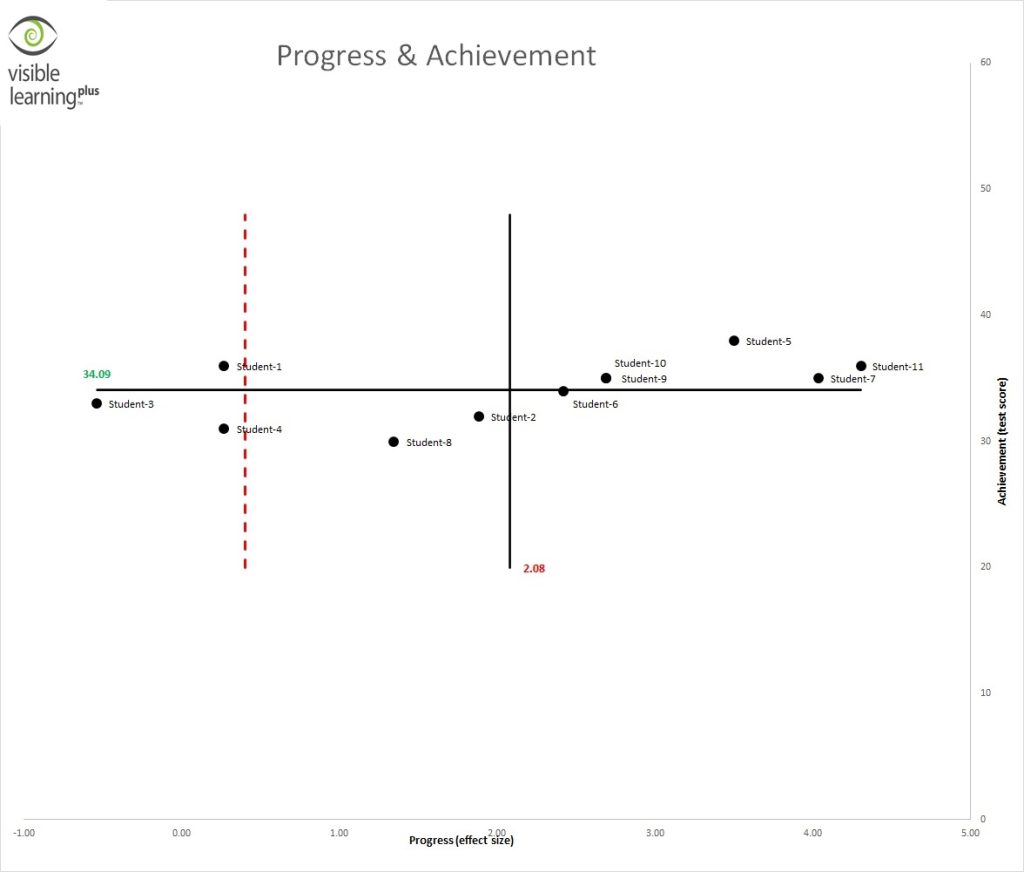
In the VLPAT graph (Figure 2), the x-axis represents “Student Progress (Effect Size),” and the y-axis represents “Student Achievement (Score Points).” The VLPAT graph has generated all students’ academic achievement on average is 34.09 out of 40 score points (85.2%), and academic progress on average is 2.08 effect-size. According to Hattie (2012), the average effect-size is 0.4, considered the hinge-point. Therefore, if the effect-size is less than the hinge-point (0.4), student academic progress occurs below the average, effect-size between 0.4 and 0.6 to be considered above average, and effect-size above 0.6 to be considered excellent. Thus, the impact of flipped learning as a pedagogy on overall students’ progress is excellent with effect-size 2.08, and students’ achievement is 85.2%. Additionally, TKI (2019) states that an effect size of above 0.4 would show that innovation is working more than expected in a classroom setting. Table 1 highlights the calculation for effect-size.
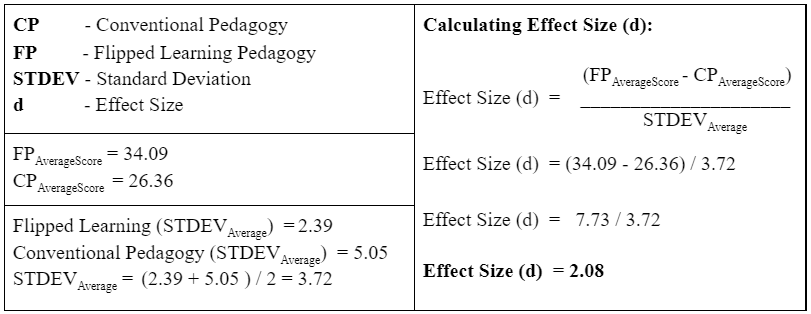
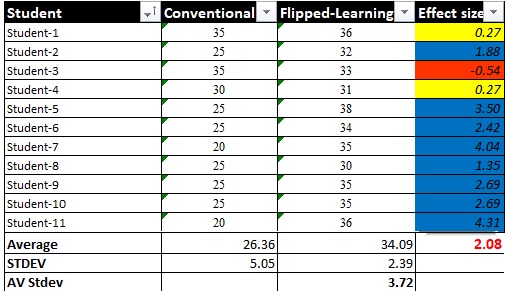
Additionally, an evaluation of flipped-learning pedagogy with Year 13 Maths learners revealed in Table 3 that the student academic progress is recorded highest for “Student – 11” with 4.31 effect-size and lowest for “Student – 3” with -0.54 effect-size, whereas the student academic achievement is recorded highest for “Student – 5” with score points 95% and lowest for “Student – 8” with 75%.
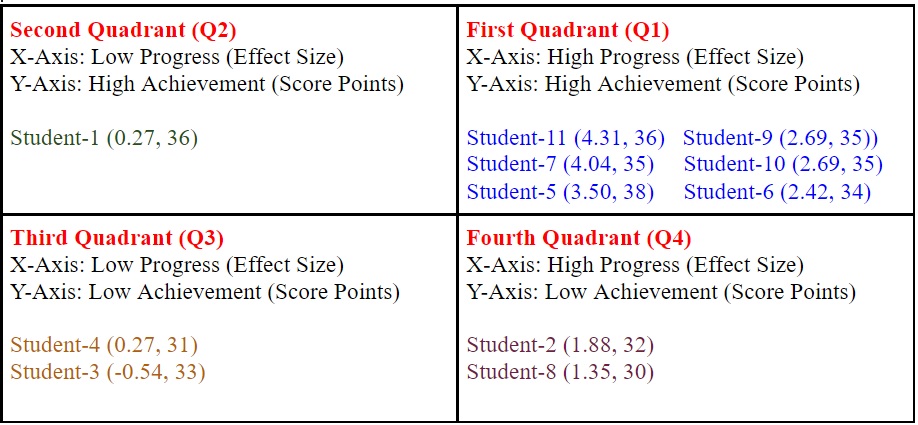
In Figure 2, the VLPAT graph, four quadrants determine the students’ academic progress and achievement. The results are summarised in Table 3. First Quadrant Q1: The students with high progress and high achievement belong to Q1, and they are as follows: 1) “Student – 11” with effect-size 4.31 and score points 90%. 2) “Student – 7” with effect-size 4.04 and score points 88%. 3) “Student – 5” with effect-size 3.50 and score points 95%. 4) “Student – 9” with effect-size 2.69 and score points 88%. 5) “Student – 10” with effect-size 2.69 and score points 88%. 6) “Student – 6” with effect-size 2.42 and score points 85%.
Second Quadrant Q2: The students with low progress and high achievement belong to Q2, and they are “Student – 1” with effect-size 0.27 and score points 90%. Third Quadrant Q3: The students with low progress and low achievement belong to Q3, and they are as follows: 1) “Student – 4” with effect-size 0.27 and score points 78%, 2) “Student – 3” with effect-size -0.54 and score points 83%. Fourth Quadrant Q4: The students with high progress and low achievement belong to Q4, and they are as follows: 1) “Student – 2” with effect-size 1.88 and score points 80%, 2) “Student – 8” with effect-size 1.35 and score points 75%.
Indeed Bishop’s (2019) study states that effective teachers are positioned in Q1 (teaching to the North-East) with “High Teaching Skills and High Relationships”, with the learners as a metaphor of Hattie’s (2012) study where learning is highly visible in Q1 (High Progress and High Achievement).
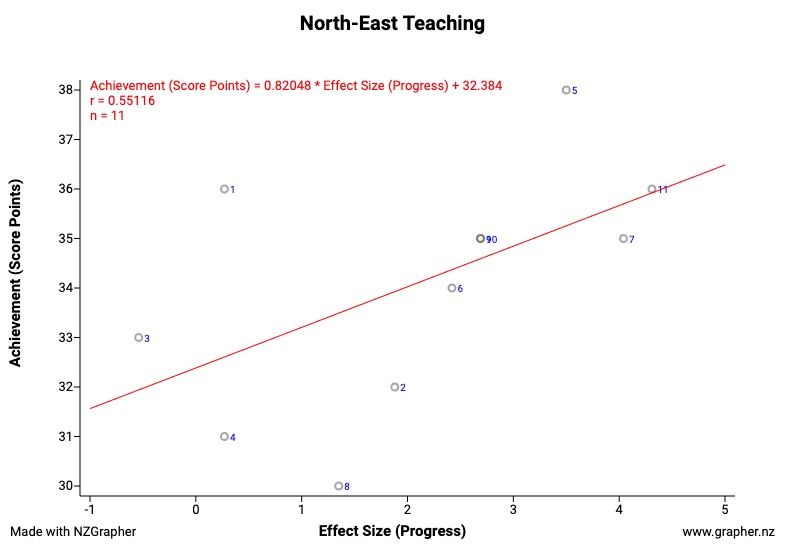
Thus, the “Teaching to the North-East” graph has been generated using the NZGrapher tool, see Figure 3. The red line clearly shows that the impact of flipped-learning pedagogy is positive, and moving towards North-East Q1 puts relational leadership at the centre of learning to raise students’ academic achievement and progress.
EP Analysis
Figure 4 shows an evaluation of flipped-learning pedagogy using the Education Perfect (EP) tool. This resulted in 19.3% academic improvement on average for all Year 13 Maths students compared to conventional pedagogy. In saying this, the average academic outcome of conventional pedagogy is 65.9%, whereas flipped-learning pedagogy is 85.2%.

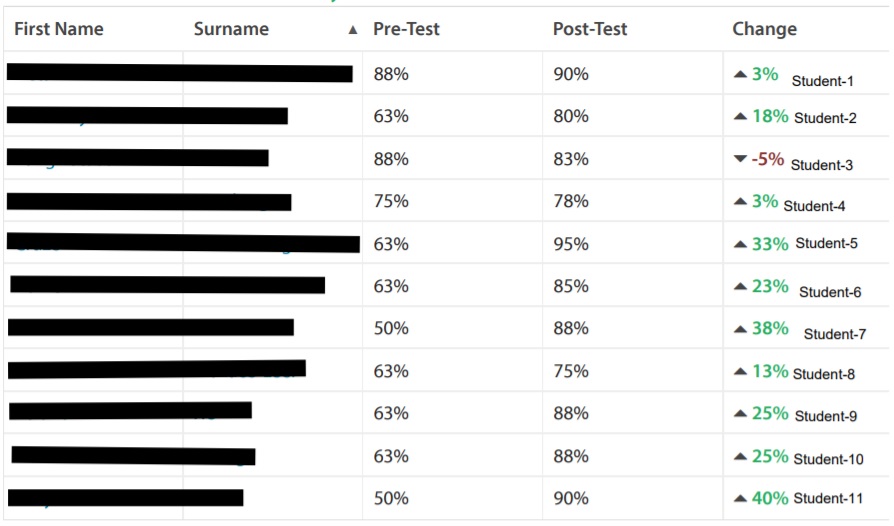
According to Melville (2019), the biggest challenge of being a teacher is balancing teacher time in the class; therefore, tools such as Education Perfect (EP) help teachers to be more effective, efficient, and responsive to the students’ requirements. Similarly, Cabi’s (2018) study states that the results of flipped-learning environments revealed that using mathematics software, digital content, and instructional videos doubled the learners’ academic progress and facilitated learning by visualising mathematics content that enhanced permanent learning.
Absent Work Analysis
Table 5 shows the list of absent students for each flipped-learning lesson and also displays whether each absent student has completed the tasks or not. The tasks include watching the instructional video, understanding and answering open-ended questions, and collaborating with other students and the teacher.
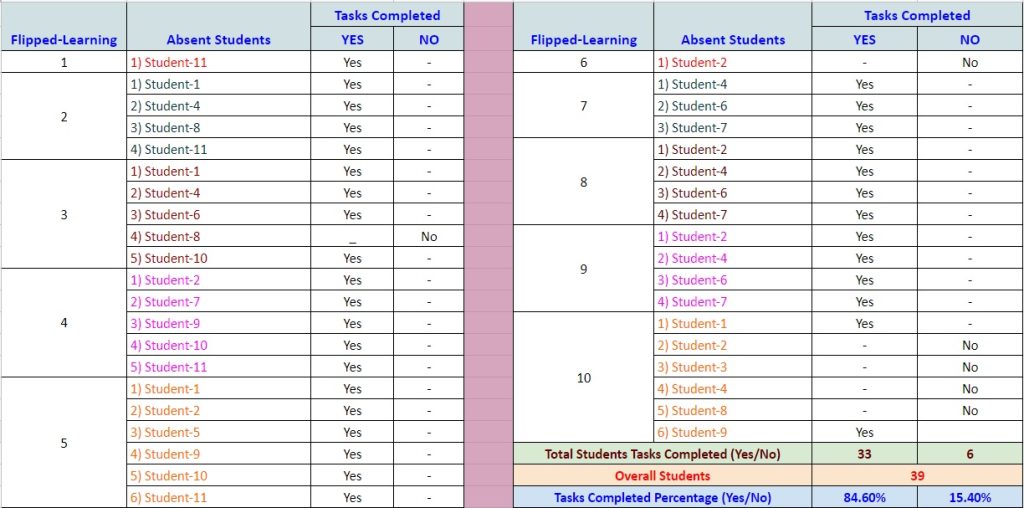
The results of absent work analysis show that 33 out of 39 students who were absent for the ten flipped-learning lessons were able to successfully catch up on the lessons they missed by watching the instructional videos from home in their own time, understanding the concept, and completing open-ended tasks. Thus, the impact of the flipped-learning pedagogical approach on Year 13 Maths students who were absent was 84.6% successful in completing their work before coming to the next lesson. Furthermore, overall, 39 students missed ten flipped-learning lessons, which means, on average, 3.9 students (approximately four students) were absent for each flipped-learning lesson. Hence, this indicates that about four students in each lesson – and it may not be the same students in every lesson – will struggle to establish the link with the previous lesson if there is no flipped-learning pedagogical approach in place.
Conclusion and Recommendations
This research report, however, makes several noteworthy contributions to the flipped-learning approaches. The significant findings from the flipped-learning collaborations revealed the factors that contributed to students’ progress are as follows: a) Instructional videos were very clear with concise instructions and easy-to-understand concepts, with flexibility to catch up on the lesson anytime anywhere for those who were absent, and the ability to revisit the lesson when students had any questions and have more information than a teacher can do on the board or in the classroom. b) Open-ended tasks allowed the students to develop their ideas with multiple correct answers and apply in-depth curriculum knowledge by working at their own pace, in multiple ways, and at different levels. c) Leadership and collaboration met individual learning needs by reaching every student in every lesson and catching up with the absent students, allowed sharing ideas in small groups and with the whole class, heard different views of discussions to find the solution, enhanced the faster way to learn the concepts, encouraged learners’ participation, and gave more control around the learning process.
The results of the VLPAT analysis show that the learning is visible, and teaching is to the North-East – the impact of flipped learning as a pedagogy on overall student progress is strong with effect-size 2.08, and on students’ academic achievement is 85.2%. Additionally, the student academic progress is recorded highest for “Student – 11” with 4.31 effect-size and lowest for “Student – 3” with -0.54 effect-size, whereas the student academic achievement is recorded highest for “Student – 5” with score points 95% and lowest for “Student – 8” with 75%. The outcomes of EP analysis have resulted in 19.3% academic improvement on average compared to conventional pedagogy. Furthermore, the student academic improvement using flipped learning is recorded highest for “Student – 11” with 40% and lowest for “Student – 3” with -5%. The Absent Work Analysis highlights that 84.6% of absent students could successfully catch up on the lessons they missed because of flipped-learning pedagogy. Therefore, using a flipped-learning pedagogical approach significantly improved student academic achievement and progress over the conventional teaching approach. However, in-depth evaluation highlights that the low and average-achievers performed better using a flipped-learning approach, whereas the high-achievers’ academic outcomes remained nearly the same.
Future research could include incorporating Edpuzzle in the instructional videos to add more dynamic open-ended tasks. This technique will make the video lessons more interactive and encourage students towards self-paced learning. Similarly, Baker’s (2016) studies found that EdPuzzle is an excellent tool for teachers who use flipped-learning pedagogical approaches because it offers interactive features such as students’ open-ended questions answered in the instructional video, and it helps redefine learning.
Limitations
This researcher acknowledges there are some limitations, such as comparability of the data collected. For example, although the topics taught using conventional pedagogy and flipped-learning approach were equivalent in terms of difficulty and at the same level based on NCEA Year 13 curriculum standards, perhaps collecting the data from the same number of tests (e.g. ten tests Conventional Pedagogy and ten tests flipped learning) would have been more credible. For example, in this research, the data collected (scores) from the flipped-learning approach comprises ten tests (four marks each test) that totals up to 40 marks. Whereas the data collected (scores) from the conventional pedagogy was from one 40-mark test, instead of collecting data from ten tests (four marks each test) which could have resulted in more reliable and valid data.
References
Baker, A. (2016). EdPuzzle | Online Tools for Teaching & Learning. Active Learning with Interactive Videos: Creating Student-Guided Learning Materials. Journal of Library & Information Services in Distance Learning, 1-9. Retrieved October 14, 2020, from https://blogs.umass.edu/onlinetools/assessment-centered-tools/edpuzzle/
Bhagat, K. K., Chang, C. N., & Chang, C. Y. (2016). The Impact of the Flipped Classroom on Mathematics Concept Learning in High School. Journal of Educational Technology & Society, 19(3), 134–142. http://www.jstor.org/stable/jeductechsoci.19.3.134
Bishop, R. (2019). Teaching to the North-East. New Zealand Council for Educational Research. https://www.nzcer.org.nz/nzcerpress/books/teaching-north-east
Bishop, J. L., & Verleger, M. A. (2013). The flipped classroom: a survey of the research [Conference presentation]. The 120th ASEE National Conference and Exposition, Atlanta, GA (Paper ID 6219). Washington, DC. American Society for Engineering Education. https://peer.asee.org/the-flipped-classroom-a-survey-of-the-research
Bob, D. (2020). Beginners’ guide to action research – Resource papers in action research. http://www.aral.com.au/resources/guide.html
Cabi, E. (2018). The Impact of the Flipped Classroom Model on Students’ Academic Achievement. International Review of Research in Open and Distributed Learning, 19(3). http://www.irrodl.org/index.php/irrodl/article/view/3482/4647
Credforce (2020). Education 4.0: Rise of Flexible Learning in the ‘New World’. Retrieved August 19, 2021. https://www.credforce.com/spotlight/article/education-4-rise-of-flexible-learning-in-the-new-world
Education Perfect (2020). How does online learning impact results in national assessments? Retrieved June 20, 2021. https://www.educationperfect.com/wp-content/uploads/2020/11/EP-NZQA-Analysis.pdf
Francl, T. J. (2014). Is Flipped Learning Appropriate? Journal of Research in Innovative Teaching, 7(1), 119–128. https://www.nu.edu/wp-content/uploads/2018/11/journal-of-research-in-innovative-teaching-volume-7.pdf
Gundlach, E., Richards, K. A. R., Nelson, D., & Levesque-Bristol, C. (2015). A comparison of student attitudes, statistical reasoning, performance, and perceptions for web-augmented traditional, fully online, and flipped sections of a statistical literacy class. Journal of Statistics Education, 23(1), 1–33. https://doi.org/10.1080/10691898.2015.11889723
Harmon, W. (2017). Instructional Strategies – How to use Flipped Learning to Support Absent Students. Retrieved October 14, 2020, from https://theartofeducation.edu/2017/07/31/use-flipped-learning-support-absent-students/
Hancock, K., Shepherd, C., Lawrence, D., & Zubrick, S. (2013). Student Attendance and Educational Outcomes: Every Day Counts. http://doi.org/10.13140/2.1.4956.6728
Hattie, J. (2012). Visible learning for teachers: Maximizing impact on learning. Routledge/Taylor & Francis Group.
Lalongo C. (2016). Understanding the effect size and its measures. Biochemia medica, 26(2), 150–163. https://doi.org/10.11613/BM.2016.015
Lo, C & Hew, K. (2017). A critical review of flipped classroom challenges in K-12 education: Possible solutions and recommendations for future research. Research and Practice in Technology Enhanced Learning. 12. 1-22. https://doi.org/10.1186/s41039-016-0044-2
Mayer, R.E., Fiorella, L. & Stull, A. (2020). Five ways to increase the effectiveness of instructional video. Education Tech Research Dev, 68, 837–852 (2020). https://doi.org/10.1007/s11423-020-09749-6
Maciejewski, W. (2015). Flipping the calculus classroom: An evaluative study. Teaching Mathematics and its Applications. 35(4). https://doi.org/10.1093/teamat/hrv019
Melville, B. (2019). New look, same core focus for Education Perfect. Otago Daily Times. Retrieved October 14, 2020, from https://www.odt.co.nz/business/new-look-same-core-focus-education-perfect
Neely, C. (2019). Using Open-Ended Questions in the Classroom. Retrieved October 08, 2020, from http://info.teachstone.com/blog/open-ended-questions-in-the-classroom
Nuhoğlu Kibar, P., Gündüz, A. Y., & Akkoyunlu, B. (2020). Implementing Bring Your Own Device (BYOD) Model in Flipped Learning: Advantages and Challenges. Technology, Knowledge and Learning, 25(3), 465–478. https://doi.org/10.1007/s10758-019-09427-4
Priscila (2020). What is self-paced learning? Meaning explained. Retrieved August 19, 2021, from https://www.easy-lms.com/help/lms-knowledge-center/self-paced-learning-definition/item10384
Robert, K. (2015). Is Depth of Knowledge Complex or Complicated? Retrieved April 13, 2020, from https://robertkaplinsky.com/is-depth-of-knowledge-complex-or-complicated/
Taffard, K. (2020). “Good” (Open-ended) Questions. Retrieved from https://docs.google.com/presentation/d/1nmYWw2tRpZbG_2rxeLaApgV3WhX8cEtTS3vh44bNw7g/edit#slide=id.g62ac6111ce_0_494
TKI (2019). Effect size / Concepts / Working with data / Using evidence for learning. Retrieved October 14, 2020, from https://assessment.tki.org.nz/Using-evidence-for-learning/Working-with-data/Concepts/Effect-size
Wisdom, J., & Creswell, J. (2013). Mixed Methods: Integrating Quantitative and Qualitative Data Collection and Analysis While Studying Patient-Centered Medical Home Models. Rockville, MD: Agency for Healthcare Research and Quality. February 2013. AHRQ Publication No. 13-0028-EF. Retrieved from https://pcmh.ahrq.gov/sites/default/files/attachments/MixedMethods_032513comp.pdf
Yoshida, H. (2016). Perceived Usefulness of “Flipped Learning” on Instructional Design for Elementary and Secondary Education: With Focus on Pre-service Teacher Education. International Journal of Information and Education Technology. 6. 430-434. https://doi.org/10.7763/IJIET.2016.V6.727
The opinions expressed are those of the paper author(s) and not He Rourou or The Mind Lab.
He Rourou by The Mind Lab is licensed under a Creative Commons Attribution-NonCommercial-ShareAlike 4.0 International License, except where otherwise noted. [ISSN 2744-7421]

